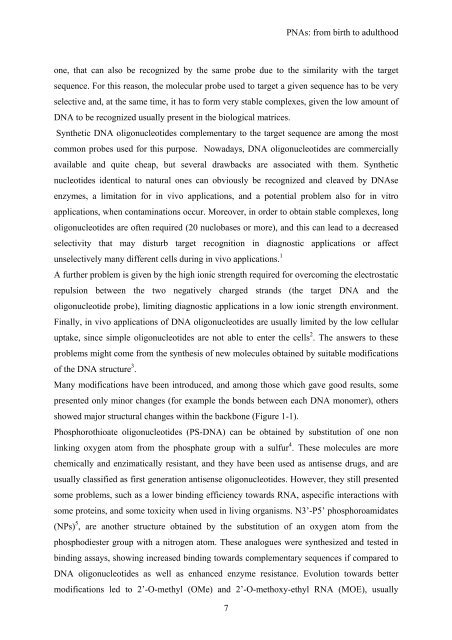View - DSpace UniPR
View - DSpace UniPR
View - DSpace UniPR
Create successful ePaper yourself
Turn your PDF publications into a flip-book with our unique Google optimized e-Paper software.
PNAs: from birth to adulthood<br />
one, that can also be recognized by the same probe due to the similarity with the target<br />
sequence. For this reason, the molecular probe used to target a given sequence has to be very<br />
selective and, at the same time, it has to form very stable complexes, given the low amount of<br />
DNA to be recognized usually present in the biological matrices.<br />
Synthetic DNA oligonucleotides complementary to the target sequence are among the most<br />
common probes used for this purpose. Nowadays, DNA oligonucleotides are commercially<br />
available and quite cheap, but several drawbacks are associated with them. Synthetic<br />
nucleotides identical to natural ones can obviously be recognized and cleaved by DNAse<br />
enzymes, a limitation for in vivo applications, and a potential problem also for in vitro<br />
applications, when contaminations occur. Moreover, in order to obtain stable complexes, long<br />
oligonucleotides are often required (20 nuclobases or more), and this can lead to a decreased<br />
selectivity that may disturb target recognition in diagnostic applications or affect<br />
unselectively many different cells during in vivo applications. 1<br />
A further problem is given by the high ionic strength required for overcoming the electrostatic<br />
repulsion between the two negatively charged strands (the target DNA and the<br />
oligonucleotide probe), limiting diagnostic applications in a low ionic strength environment.<br />
Finally, in vivo applications of DNA oligonucleotides are usually limited by the low cellular<br />
uptake, since simple oligonucleotides are not able to enter the cells 2 . The answers to these<br />
problems might come from the synthesis of new molecules obtained by suitable modifications<br />
of the DNA structure 3 .<br />
Many modifications have been introduced, and among those which gave good results, some<br />
presented only minor changes (for example the bonds between each DNA monomer), others<br />
showed major structural changes within the backbone (Figure 1-1).<br />
Phosphorothioate oligonucleotides (PS-DNA) can be obtained by substitution of one non<br />
linking oxygen atom from the phosphate group with a sulfur 4 . These molecules are more<br />
chemically and enzimatically resistant, and they have been used as antisense drugs, and are<br />
usually classified as first generation antisense oligonucleotides. However, they still presented<br />
some problems, such as a lower binding efficiency towards RNA, aspecific interactions with<br />
some proteins, and some toxicity when used in living organisms. N3’-P5’ phosphoroamidates<br />
(NPs) 5 , are another structure obtained by the substitution of an oxygen atom from the<br />
phosphodiester group with a nitrogen atom. These analogues were synthesized and tested in<br />
binding assays, showing increased binding towards complementary sequences if compared to<br />
DNA oligonucleotides as well as enhanced enzyme resistance. Evolution towards better<br />
modifications led to 2’-O-methyl (OMe) and 2’-O-methoxy-ethyl RNA (MOE), usually<br />
7
















